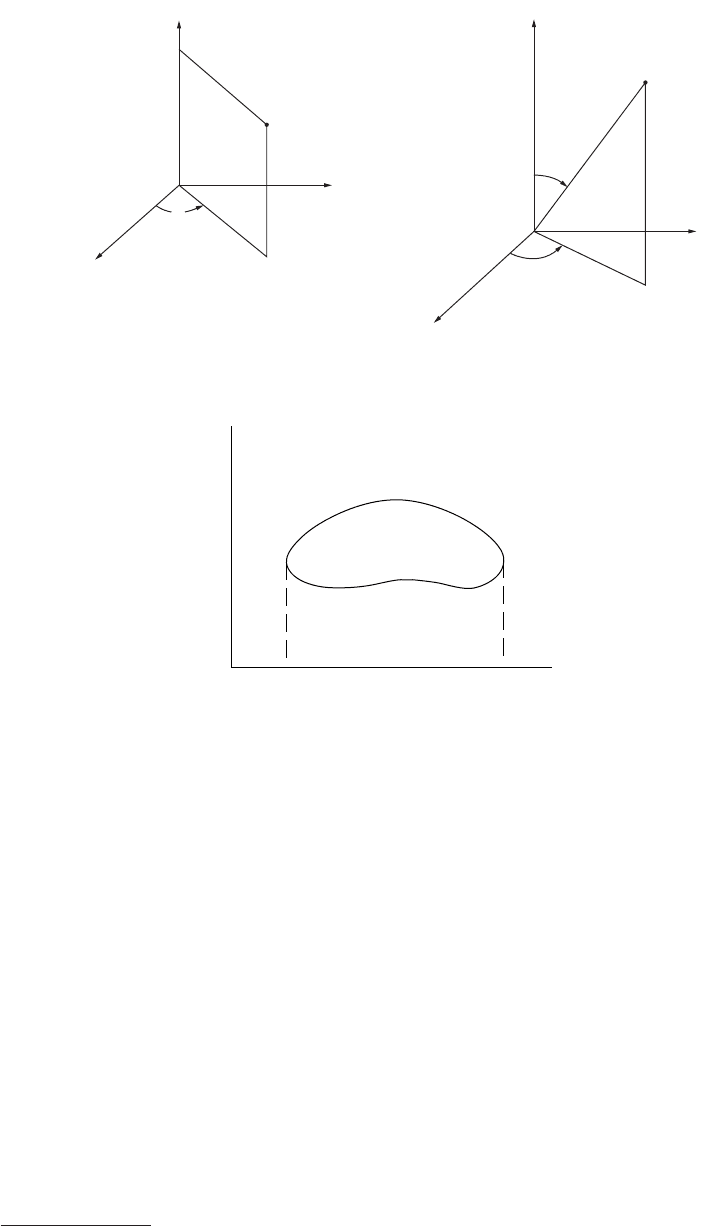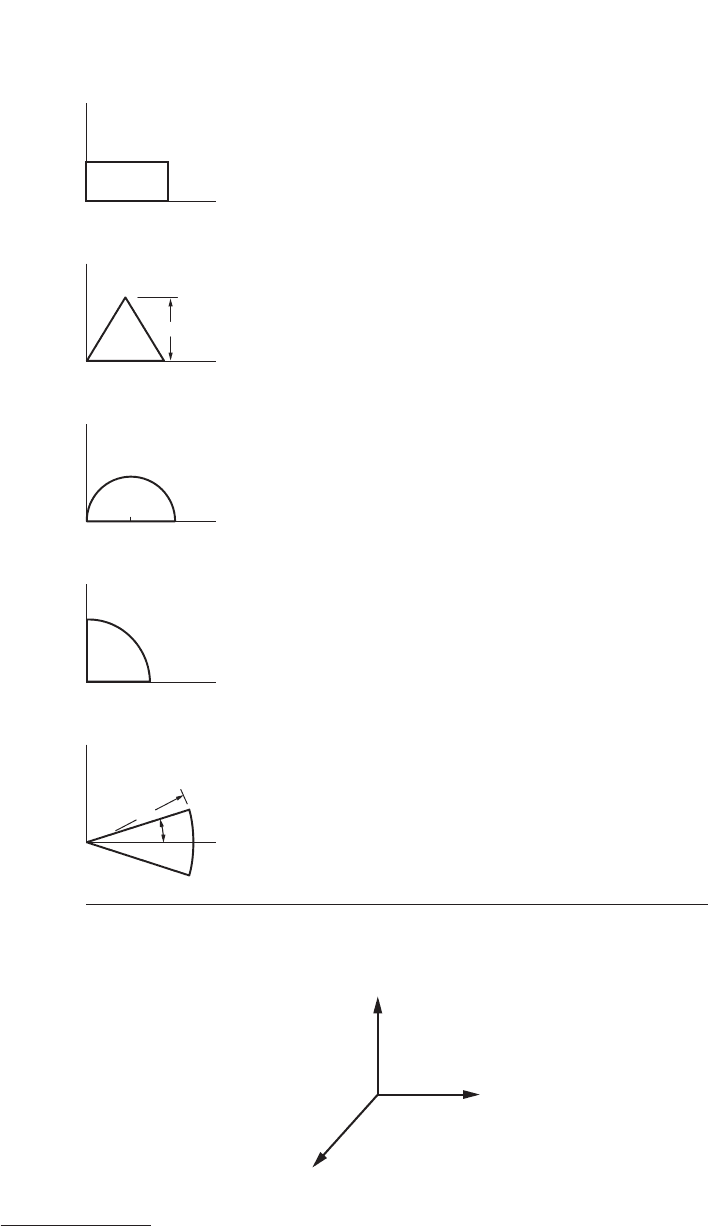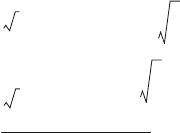Wai-Fah Chen.The Civil Engineering Handbook
Подождите немного. Документ загружается.


© 2003 by CRC Press LLC
The Gas Laws
A familiar example is afforded by the ideal gas law that relates the pressure p, the volume V, and the
absolute temperature
T of an ideal gas:
where n is the number of moles and R is the gas constant per mole, 8.31 (J · K
–1
· mole
–1
). By rearrange-
ment, any one of the three variables may be expressed as a function of the other two. Further, either one
of these two may be held constant. If
T is held constant, then we get the form known as Boyle’s law:
(Boyle’s law)
where we have denoted nRT by the constant k and, of course, V > 0. If the pressure remains constant,
we have Charles’ law:
(Charles’ law)
where the constant b denotes nR/p. Similarly, volume may be kept constant:
where now the constant, denoted a, is nR/V.
Partial Derivatives
The physical example afforded by the ideal gas law permits clear interpretations of processes in which
one of the variables is held constant. More generally, we may consider a function
z = f (x, y) defined
over some region of the
x–y-plane in which we hold one of the two coordinates, say y, constant. If the
resulting function of
x is differentiable at a point (x, y), we denote this derivative by one of the notations
called the partial derivative with respect to x. Similarly, if x is held constant and the resulting function of
y is differentiable, we get the partial derivative with respect to y, denoted by one of the following:
Example
Integral Calculus
Indefinite Integral
If F (x) is differentiable for all values of x in the interval (a, b) and satisfies the equation dy /dx = f (x),
then
F (x) is an integral of f (x) with respect to x. The notation is F (x) = ∫ f (x) dx or, in differential form,
dF (x) = f (x) dx.
For any function F (x) that is an integral of f (x), it follows that F (x) + C is also an integral. We thus write
pV nRT=
pkV
1–
=
VbT=
paT=
f
x
δ
fdx,⁄
δ
zdx⁄,
f
y
,
δ
fdy⁄
δ
zdy⁄,
Given zx
4
y
3
yx4y, then+sin–=
δ
zdx⁄ 4 xy()
3
yxcos–=
δ
zdy⁄ 3x
4
y
2
x 4+sin–=
fx()xd
∫
Fx() C+=

© 2003 by CRC Press LLC
Definite Integral
Let f (x) be defined on the interval [a, b] which is partitioned by points x
1
, x
2
, K, x
j
, K, x
n – 1
between a =
x
0
and b = x
n
. The j th interval has length ∆x
j
= x
j
– x
j – 1
, which may vary with j. The sum
where
υ
j
is arbitrarily chosen in the jth subinterval, depends on the numbers x
0
, K, x
n
and the choice
of the
υ
as well as f ; however, if such sums approach a common value as all ∆x approach zero, then this
value is the definite integral of
f over the interval (a, b) and is denoted . The fundamental theorem
of integral calculus states that
where F is any continuous indefinite integral of f in the interval (a, b).
Properties
, if c is a constant
Common Applications of the Definite Integral
Area (Rectangular Coordinates)
Given the function y = f (x) such that y > 0 for all x between a and b, the area bounded by the curve y =
f (x), the x-axis, and the vertical lines x = a and x = b is
Length of Arc (Rectangular Coordinates)
Given the smooth curve f (x, y) = 0 from point (x
1
, y
1
) to point (x
2
, y
2
), the length between these points is
Mean Value of a Function
The mean value of a function f (x) continuous on [a, b] is
Σ
j 1=
n
f υ
j
()∆x
j
,
fx()xd
a
b
∫
fx()xd
a
b
∫
Fb() Fa()–=
f
1
x() f
2
x() L f
j
x()+++[ ] xd
a
b
∫
f
1
x()xf
2
x()x L f
j
x()xd
a
b
∫
++d
a
b
∫
+d
a
b
∫
=
cf x()xd
a
b
∫
cfx()xd
a
b
∫
=
fx()xd
a
b
∫
fx()xd
b
a
∫
–=
fx()xd
a
b
∫
fx()xd
a
c
∫
fx()xd
c
b
∫
+=
Afx()xd
a
b
∫
=
L 1 ydxd⁄()
2
+ xd
x
1
x
2
∫
=
L 1 xdyd⁄()
2
+ yd
y
1
y
2
∫
=
1
ba–()
----------------
fx()xd
a
b
∫

© 2003 by CRC Press LLC
Area (Polar Coordinates)
Given the curve r = f (
θ
), continuous and non-negative for
θ
1
≤
θ
≤
θ
2
, the area enclosed by this curve
and the radial lines
θ
=
θ
1
and
θ
=
θ
2
is given by
Length of Arc (Polar Coordinates)
Given the curve r = f (
θ
) with continuous derivative f ′(
θ
) on
θ
1
≤
θ
≤
θ
2
, the length of arc from
θ
=
θ
1 t
o
θ
=
θ
2
is
Volume of Revolution
Given a function y = f (x), continuous and non-negative on the interval (a, b), when the region bounded
by
f (x) between a and b is revolved about the x-axis, the volume of revolution is
Surface Area of Revolution
(Revolution about the x-axis, between a and b)
If the portion of the curve y = f (x) between x = a and x = b is revolved about the x-axis, the area A of
the surface generated is given by the following:
Work
If a variable force f (x) is applied to an object in the direction of motion along the x-axis between x = a
and x = b, the work done is
Cylindrical and Spherical Coordinates
a. Cylindrical coordinates (Figure 31)
element of volume dV = r dr d
θ
dz.
b.Spherical coordinates (Figure 32)
element of volume dV =
ρ
2
sin
φ
d
ρ
, d
φ
d
θ
.
A
1
2
--
f
θ
()[]
2
θ
d
θ
1
θ
2
∫
=
Lf
θ
()[]
2
f ′
θ
()[]
2
+
θ
d
θ
1
θ
2
∫
=
V
π
fx()[]
2
xd
a
b
∫
=
A 2
π
fx()1 f
′
x()[]
2
+{ }
12⁄
xd
a
b
∫
=
Wfx()xd
a
b
∫
=
xr
θ
cos=
yr
θ
sin=
x
ρφ
θ
cossin=
y
ρφ
θ
sinsin=
z
ρφ
cos=

© 2003 by CRC Press LLC
Double Integration
The evaluation of a double integral of f (x, y) over a plane region R
is practically accomplished by iterated (repeated) integration. For example, suppose that a vertical straight
line meets the boundary of
R in at most two points so that there is an upper boundary, y = y
2
(x), and a
lower boundary,
y = y
1
(x). Also, it is assumed that these functions are continuous from a to b (see
Figure
33). Then
If R has a left-hand boundary, x = x
1
(y), and a right-hand boundary, x = x
2
(y), which are continuous
from
c to d (the extreme values of y in R), then
FIGURE 31 Cylindrical coordinates. FIGURE 32 Spherical coordinates.
FIGURE 33 Region R bounded by y
2
(x) and y
1
(x).
z
P
z
r
y
x
q
r
q
j
y
z
P
x
y
2
(x)
y
1
(x)
x
ba
y
fxy,()Ad
R
∫∫
fxy,()Ad
R
∫∫
fxy,()yd
y
1
x()
y
2
x()
∫
xd
a
b
∫
=
fxy,() Ad
R
∫∫
fxy,() xd
x
1
y()
x
2
y()
∫
yd
c
d
∫
=

© 2003 by CRC Press LLC
Such integrations are sometimes more convenient in polar coordinates, x = r cos
θ
, y = r sin
θ
; dA =
r dr d
θ
.
Surface Area and Volume by Double Integration
For the surface given by z = f (x, y), which projects onto the closed region R of the x–y-plane, one may
calculate the volume
V bounded above by the surface and below by R, and the surface area S by the
following:
[In polar coordinates (r,
θ
), we replace dA by r dr d
θ
].
Centroid
The centroid of a region R of the x–y-plane is a point (x′, y′) where
and A is the area of the region.
Example.
For the circular sector of angle 2α and radius R, the area A is α R
2
; the integral needed for x′, expressed
in polar coordinates, is
Thus,
Centroids of some common regions are shown in Figure 34.
Vector Analysis
Vectors
Given the set of mutually perpendicular unit vectors i, j, and k (Figure 35), any vector in the space may
be represented as F = ai + bj + ck, where a, b, and c are components.
Magnitude of F
VzAd
R
∫∫
fxy,()xdyd
R
∫∫
==
S 1
δ
z
δ
x⁄()
2
δ
z
δ
y⁄()
2
++[ ]
12⁄
xdyd
R
∫∫
=
x′
1
A
---
xA
y
′
1
A
-
-
-
yA
d
R
∫
∫
=
d
R
∫
∫
=
x Ad
∫∫
r
θ
cos()r rd
θ
d
0
R
∫
α
–
α
∫
=
R
3
3
-----
θ
sin
α
–
α
+
2
3
--
R
3
α
sin= =
x′
2
3
--
R
3
α
sin
α
R
2
---------------------
2
3
--
R
α
sin
α
-----------
= =
F a
2
b
2
c
2
++( )
1
2
--
=

© 2003 by CRC Press LLC
FIGURE 34
FIGURE 35 The unit vectors i, j, and k.
y
x
y
x
y
x
y
x
y
x
(rectangle)
h
h
b
(isos. triangle)*
(semicircle)
R
(quarter circle)
R
(circular sector)
*y′ = h/3 for any triangle of altitude h.
R
A
Area x
′
y
′
bh b/2 h/2
bh/2 b/2 h/3
pR
2
/2 R 4R/3p
pR
2
/4 4R/3p 4R/3p
R
2
A 2R sin A/3A 0
Centroids
k
j
i

© 2003 by CRC Press LLC
Product by Scalar p
Sum of F
1
and F
2
Scalar Product
(Thus, i · i = j · j = k · k = 1 and i · j = j · k = k · i = 0.) Also,
Vector Product
(Thus, i × i = j × j = k × k = 0, i × j = k, j × k = i, and k × i = j.) Also,
Vector Differentiation
If V is a vector function of a scalar variable t, then
and
For several vector functions V
1
, V
2
, K, V
n
pF pai pbj pck++=
F
1
F
2
+ a
1
a
2
+()i b
1
b
2
+()j c
1
c
2
+()k+ +=
F
1
F
2
⋅ a
1
a
2
b
1
b
2
c
1
c
2
++=
F
1
F
2
⋅ F
2
F
1
⋅=
F
1
F
2
+()F
3
⋅ F
1
F
3
F
2
F
3
⋅+⋅=
F
1
F
2
×
i j k
a
1
b
1
c
1
a
2
b
2
c
2
=
F
1
F
2
× F
2
F
1
×–=
F
1
F
2
+()F
3
× F
1
F
3
F
2
F
3
×+×=
F
1
F
2
F
3
+()× F
1
F
2
F
1
F
3
×+×=
F
1
F
2
F
3
×()× F
1
F
3
⋅()F
2
F
1
F
2
⋅()F
3
–=
F
1
F
2
F
3
×()⋅ F
1
F
2
×()F
3
⋅=
V at()i bt()j ct()k++=
dV
dt
-------
da
dt
------
i
db
dt
------
j
dc
dt
-----
k++=
d
dt
-----
V
1
V
2
L V
n
+++( )
dV
1
dt
---------
dV
2
dt
--------- L
dV
n
dt
---------+++=
d
dt
-----
V
1
V
2
⋅()
dV
1
dt
---------
V
2
V
1
dV
2
dt
---------
⋅+⋅=
d
dt
-----
V
1
V
2
×()
dV
1
dt
---------
V
2
V
1
dV
2
dt
---------
×+×=

© 2003 by CRC Press LLC
For a scalar-valued function g(x, y, z)
For a vector-valued function V(a, b, c), where a, b, and c are each a function of x, y, and z,
(divergence)
(curl)
Also,
and
Divergence Theorem (Gauss)
Given a vector function F with continuous partial derivatives in a region R bounded by a closed surface S,
then
where n is the (sectionally continuous) unit normal to S.
Stokes’ Theorem
Given a vector function with continuous gradient over a surface S that consists of portions that are
piecewise smooth and bounded by regular closed curves such as
C,
Planar Motion in Polar Coordinates
Motion in a plane may be expressed with regard to polar coordinates (r,
θ
). Denoting the position vector
by
r and its magnitude by r, we have r = rR(
θ
), where R is the unit vector. Also, dR/d
θ
= P, a unit vector
perpendicular to
R. The velocity and acceleration are then
gradient() grad g ∇g
δ
g
δ
x
------
i
δ
g
δ
y
------
j
δ
g
δ
z
------
k++==
divV ∇ V⋅
δ
a
δ
x
------
δ
b
δ
y
------
δ
c
δ
z
------++==
curlV ∇ V×
i j k
δ
δ
x
------
δ
δ
y
------
δ
δ
z
------
a bc
==
div grad g ∇
2
g
δ
2
g
δ
x
2
--------
δ
2
g
δ
y
2
-------
δ
2
g
δ
z
2
-------++==
curl grad g 0; div curl V 0;= =
curl curlV grad divVi∇
2
a j∇
2
b k ∇
2
c++( )–=
iv F⋅d Vd
R
∫∫∫
nFSd⋅
S
∫∫
=
n curl F⋅ Sd
S
∫∫
F dr⋅
C
∫
°
=
v
dr
dt
-----
R r
d
θ
dt
------
P+=
a
d
2
r
dt
2
------- r
d
θ
dt
------
2
–
R r
d
2
θ
dt
2
--------
2
dr
dt
-----
d
θ
dt
------
+ P+=

© 2003 by CRC Press LLC
Note that the component of acceleration in the P direction (transverse component) may also be written
so that in purely radial motion it is zero and
which means that the position vector sweeps out area at a constant rate [see Area (Polar Coordinates)
in the section entitled Integral Calculus].
Special Functions
Hyperbolic Functions
Laplace Transforms
The Laplace transform of the function f (t), denoted by F (s) or L{f (t)}, is defined
1
r
--
d
dt
-----
r
2
d
θ
dt
------
r
2
d
θ
dt
------
C cons ttan()=
xsinh
e
x
e
x–
–
2
----------------= xcsch
1
xsinh
---------------=
xcosh
e
x
e
x–
+
2
-----------------= xsech
1
xcosh
----------------=
xtanh
e
x
e
x–
–
e
x
e
x–
+
-----------------= ctnh x
1
xtanh
----------------=
x–()sinh xsinh–=
ctnh x–() ctnh x–=
x–()cosh xcosh= x–()sech xsech=
x–()tanh xtanh–=
hcsc x–() xcsch–=
xtanh
xsinh
xcosh
----------------= ctnh x
xcosh
xsinh
----------------=
h
2
x h
2
xsin–cos 1=
h
2
xcos
1
2
--
2x 1+cosh( )=
h
2
sin x
1
2
--
2x 1–cosh( )= ctnh
2
x csch
2
x– 1=
h
2
x sech
2
x–csc h
2
csc x h
2
xsec=
h
2
tan x sech
2
x+ 1=
h xy+()sin xy xysinhcosh+coshsinh=
xy+()cosh xy xysinhsinh+coshcosh=
h xy–()sin xy xysinhcosh–coshsinh=
xy–()cosh xy xysinhsinh–coshcosh=
xy+()tanh
xytanh+tanh
1 xytanhtanh+
-------------------------------------------=
xy–()tanh
xytanh–tanh
1 xytanhtanh–
------------------------------------------=
Fs() ft()e
st–
td
0
∞
∫
=

© 2003 by CRC Press LLC
provided that the integration may be validly performed. A sufficient condition for the existence of F (s)
is that
f (t) be of exponential order as t → ∞ and that it is sectionally continuous over every finite interval
in the range
t ≥ 0. The Laplace transform of g(t) is denoted by L{g(t)} or G(s).
Operations
where
(periodic)
Table of Laplace Transforms
f (t) F (s) f (t) F (s)
11/s
t 1/s
2
1/s
n
(n = 1, 2, 3, K) (a ≠ b)
(a ≠ b)
ft() Fs() ft()e
st–
td
0
∞
∫
=
af t() bg t()+ aF s() bG s()+
f ′ t() sF s() f 0()–
f ″ t() s
2
Fs() sf 0()– f ′ 0()–
f
n()
t() s
n
Fs() s
n 1–
f 0()– s
n 2–
f ′ 0()– L– f
n 1–()
0()–
tf t() F′ s()–
t
n
ft() 1–()
n
F
n()
s()
e
at
ft() Fs a–()
ft
β
–()g
β
()⋅
β
d
0
t
∫
Fs() Gs()⋅
ft a–() e
as–
Fs()
f
t
a
--
aF as()
g
β
()
β
d
0
t
∫
1
s
--
Gs()
ft c–()
δ
tc–() e
cs–
Fs()c 0>,
δ
tc–()0 if 0 tc<≤=
1if tc≥=
f
t() ft
ω
+()=
e
s
τ
–
f
τ
()
τ
d
0
ω
∫
1 e
s
ω
–
–
-----------------------------
h asin t
a
s
2
a
2
–
--------------
atcosh
s
s
2
a
2
–
--------------
t
n 1–
n 1–()!
------------------
e
at
e
bt
–
ab–
sa–()sb–()
-------------------------------
t
1
2s
-----
π
s
--- ae
at
be
bt
–
sa b–()
sa–()sb–()
-------------------------------
1
t
-----
π
s
--- tasin t
2as
s
2
a
2
+()
2
----------------------
